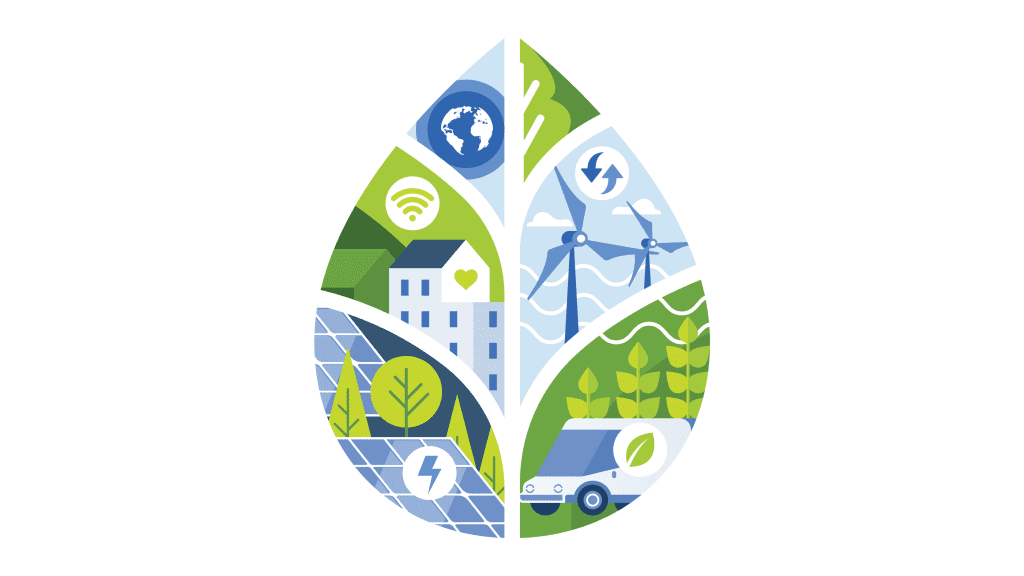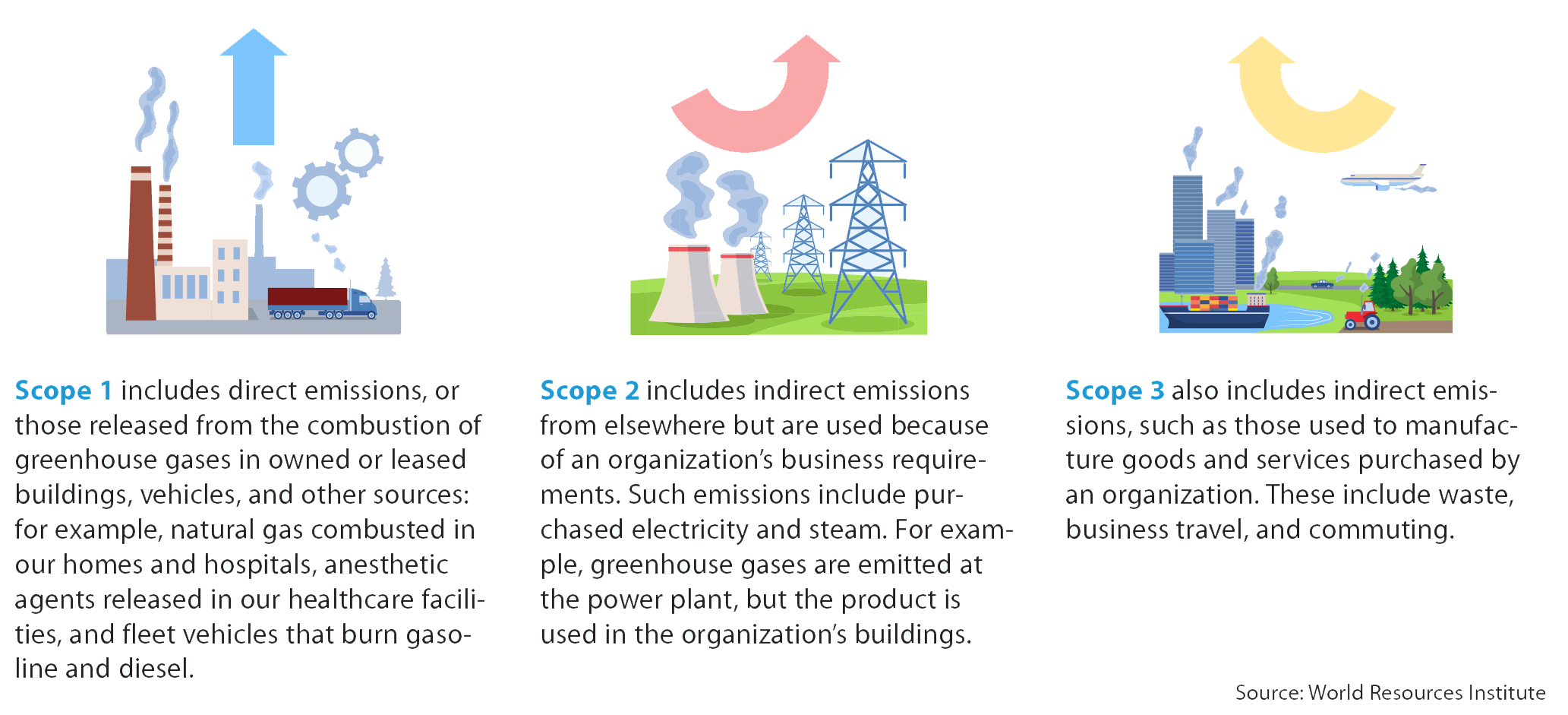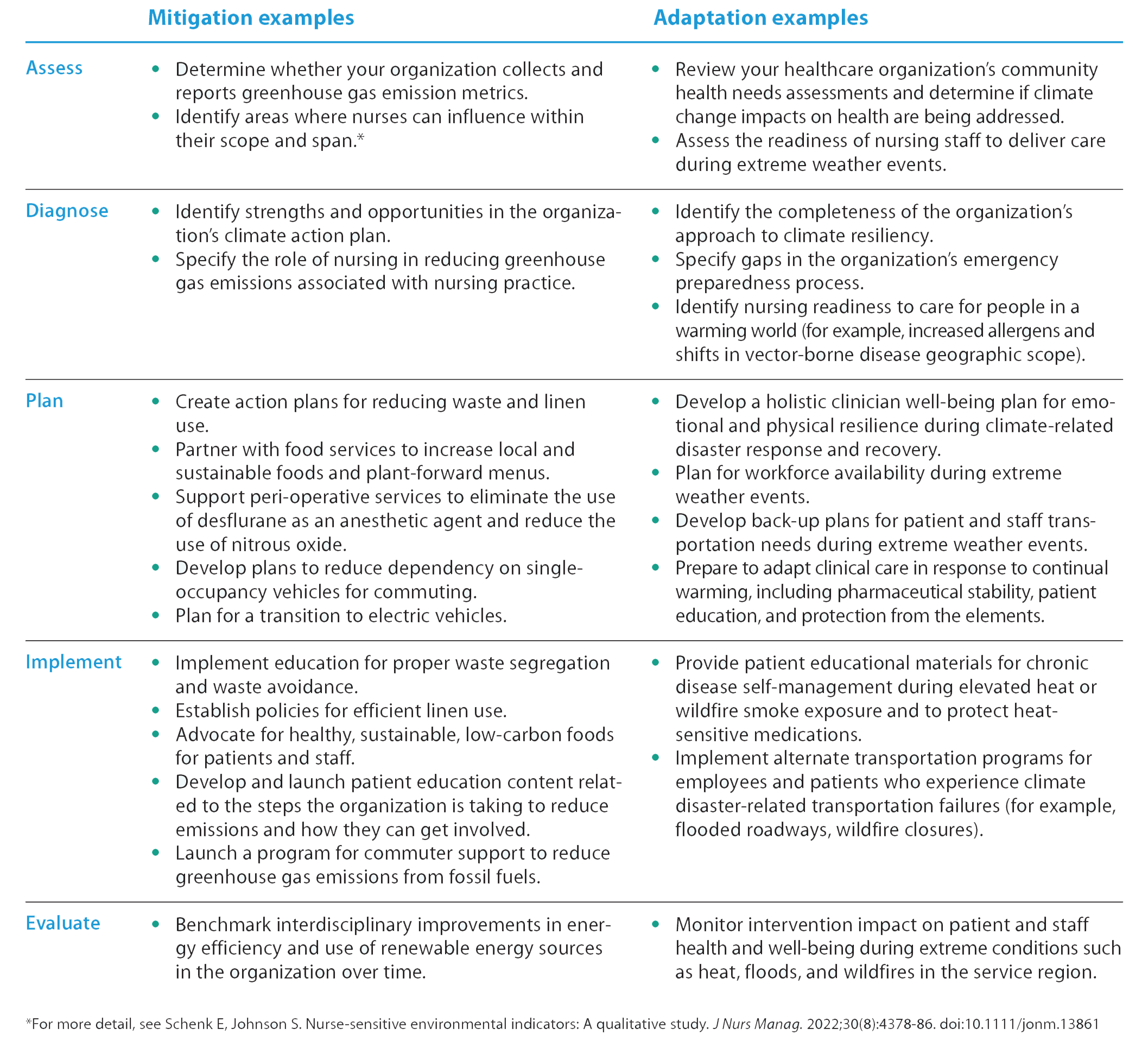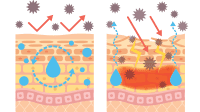Corporate social responsibility in the post-pandemic work environment
- The nursing profession must address climate change to protect and promote human health.
- Climate change activities as corporate social responsibility provide a promising avenue to both scale successful organizational initiatives and to generate hope, transformative improvements, and renewed professional commitments for nursing.
- Addressing climate change through corporate social responsibility is urgent and timely in the COVID-19 disaster recovery period for the nursing profession.
Learning Objectives
- Describe climate change activities as corporate social responsibilities for individual nurses, nurse managers, and nurse leaders.
- Describe how nurses can participate in collective actions at the organization level to address climate change.
- Identify how the timing of post-pandemic recovery opens a window of opportunity and priority for a climate change focus for the nursing profession.
Expiration: 1/1/27
At this crucial moment, in the midst of COVID-19 recovery, our collective healing requires us to re-examine and remake our professional meaning and purpose toward improvements for the next generation of nurses. We suggest climate change activities as corporate social responsibility (CSR)—which aligns with nursing’s commitment to equitable and planet-safe health—for individual nurses, nurse managers, and leaders to influence and contribute within their organizations. Understanding that nurses may find taking action overwhelming, given the massive scope and scale of climate change, we emphasize collective action at the organizational level. We must take this critical window of opportunity to expand our thinking about climate change interventions to include organizational and even broader initiatives. (See Post-pandemic trauma recovery.)
Post-pandemic trauma recovery
Post-pandemic recovery creates a critical window of opportunity for prioritizing a climate change focus within nursing. Nurses who witnessed the unprecedented deaths and ongoing health inequities of the pandemic have experienced psychological and moral injury, which has led many to express feelings of cynicism, exhaustion, and depersonalization in patient care.
Trauma erodes social systems and the personal psychological protective factors that make us feel safe, which results in feelings of disempowerment and disconnection. Therefore, recovery should focus on restoring power and control to the individual and reforming relationships or establishing new ones. The rise in natural disasters and mass trauma events that underlie public health emergencies have added new emphasis to using an evidence-informed approach to psychological interventions in trauma recovery. Hobfoll and colleagues identified five principles (safety, calm, self and community efficacy, connectedness, and hope), which are now referred to as psychological first-aid interventions, as noted in scholarship by Ursano.
Typically, trauma recovery has a personal inward focus, but some survivors may find solace in social action. Working for a social cause can create connections, and participating in collective action allows us to focus our energies on helping others and advocating for prevention. Social action can prove empowering and help to restore a sense of meaning in nursing work. It also can serve as a catalyst for promoting a sense of self and community efficacy that builds hope and optimism.
Climate change interventions
Climate change, arguably the most pressing environmental challenge of our time, also is one of the greatest health challenges. The World Health Organization’s 2023 report on monitoring health for the United Nations’ Sustainable Development Goals calls for building more climate-resilient and environmentally sustainable health systems to respond and adapt to the health crises created by climate change. Nursing, as the nation’s largest and most-trusted healthcare profession, holds a pivotal position to fortify health systems and help communities address climate change. Nurses can take several important steps to participate in and lead climate change initiatives in their workplaces.
Understand the science, know the source
First, nurses must understand the basic science of a warming planet—that an increase in anthropogenic (human-caused) greenhouse gases are trapping heat in our atmosphere. This condition has led to widespread warming and resulted in negative physical, financial, and health impacts.
To ensure advocacy effectiveness, nurses also must understand how greenhouse gases originate. The Greenhouse Gas Protocol, the global standard for categorizing greenhouse gases, describes three scopes of emission. (See Scopes of greenhouse gas emissions.)
Address the harm
Addressing the harm of climate change involves mitigation and adaptation. Mitigation requires greenhouse gas reduction to limit warming to within a livable range. Adaptation involves our response to changes already happening or anticipated. We encourage individual nurses in facilities designated as Magnet® or Pathways to Excellence® to champion mitigation and adaptation activities within their professional governance structures, and we urge individual nurses in other organizations to advocate these activities within their management, nurse leadership, and professional governance structures whenever possible. (See The nursing process and climate change.)
Access resources
Nurses can access several resources to support their climate change–related organizational assessments, diagnoses, planning, interventions, and evaluations. Sampath and colleagues, at the Agency for Healthcare Research and Quality, recently published a primer on decarbonizing healthcare, which can support nurses’ collective mitigation efforts. The Office of Climate Change and Health Equity offers several resources on their website. They include a Health Sector Resource Hub, which contains a compendium of relevant federal resources; a health professional referral guide for protecting at-risk patients from climate hazards; a quick finder to locate resources relevant to healthcare resulting from the 2022 Inflation Reduction Act; and an educational webinar series.
In addition, several key nursing organizations have developed climate change position statements, advocacy plans, and practice toolkits. You can find patient education materials at the Environmental Protection Agency for self-management during increased environmental hazard exposures, such as wildfire smoke, water contamination (including harmful algal blooms), and air pollution. At Ready.gov, the Federal Emergency Management Agency offers disaster preparedness resources for integration into clinician readiness and patient education. (See Resources.)
Resources
Take advantage for these resources to support your work on climate change initiatives.
- Agency for Healthcare Research and Quality—Reducing healthcare carbon emissions: A primer on measures and actions for healthcare organizations to mitigate climate change
ahrq.gov/healthsystemsresearch/decarbonization/index.html - Alliance of Nurses for Healthy Environments—Global Nurses Climate Change Committee
envirn.org/climate-change-committee/ - Environmental Protection Agency—Climate change and human health
epa.gov/climateimpacts/climate-change-and-human-health - Federal Emergency Management Agency—Ready
ready.gov/ - Healthcare without Harm—Climate and health program
practicegreenhealth.org/tools-and-resources/health-care-without-harm-climate-and-health-program - National Academy of Medicine—Grand challenge on climate change, human health, and equity
nam.edu/programs/climate-change-and-human-health/ - Office of Climate Change and Health Equity—Health sector resource hub
hhs.gov/climate-change-health-equity-environmental-justice/climate-change-health-equity/health-sector-resource-hub/index.html
The scope and scale of climate change require interventions well beyond the individual nurse, nursing unit, or single organization. CSR provides a well-known organizational management structure to enable cohesive and aligned nursing and interprofessional interventions to scale and spread among organizations and economic sectors.
Corporate social responsibility
Participating in collective social action can prove empowering and deepen a sense of meaning in one’s work as a nursing professional. Climate change as healthcare organizations’ CSR can serve as a promising avenue to scale successful initiatives and to generate hope, transformative improvements, and renewed professional commitments for nursing.
CSR, defined as organizational behavior expected by society or required morally and ethically, represents a type of implicit agreement or social contract in addition to, or alongside, a business’ revenue-generating mission. Healthcare organizations may appear to have inherent CSR in their revenue-generating activities. However, financial system imbalances such as those evident in the National Academy of Medicine’s 2022 report, Emerging Stronger from COVID-19: Priorities for Health System Transformation, include private insurance profitability during the pandemic. In addition, inequitable risk and financial reward at various roles in a healthcare organization, from nursing assistant to c-suite officers, have brought this inherent sense of purpose and altruism into question.
These imbalances and inequities can spark cynicism and disillusionment. Rodin and Madsbjerg emphasize how investors, money managers, and problem-solvers have altered the flow of financial resources from an original prime focus on short-term quarterly profit toward a new long-term holistic impact mindset. Although nurses who work in government and nonprofit institutions may not realize how these financial markets directly impact their work environment, they must consider that healthcare exists within an ecosystem of for-profit insurance payers, provider groups, technology companies, and product manufacturers. CSR has become a key business strategy for both nonprofit and for-profit organizations. Three key examples of CSR essentials include clinician well-being at the organizational level, equity or anti-racism, and climate change. (See Brief history of CSR.)
Brief history of CSR
Corporate social responsibility (CSR) emerged in response to the civic unrest and protests related to human rights violations and environmental pollution during the 1999 World Trade Organization meeting in Seattle, Washington. CSR strategies range from facilitating employee philanthropic giving and volunteerism to fundamentally re-engineered business practices and market initiatives.
Rodin and Madsbjerg and Lindgreen and Swaen provide important historical context on CSR. During the 2008–2009 financial crisis, several businesses across sectors cut CSR programs, describing them as ancillary activities. However, organizations that integrated CSR as a core practice experienced unexpectedly positive financial outcomes and resilience. They identified a sound business case for returns on investment related to patient/customer and community goodwill, positive employee engagement, and financing/investor interest. CSR has evolved to attract investors (impact investors) and improve long-term management practices in both for-profit and nonprofit organizations. Examples of improved long-term management practices include a holistic investment in workforce well-being, attracting investors who prioritize sustainability and community reciprocity, and centering financing decisions on holistic values.
According to the 2022 Association of American Medical Colleges’ Climate Action in Academic Medicine report, CSR served as a motivator for chief executive officers (CEOs) of academic health centers to address climate change in their institutions. CEO comments in the report addressed the following key themes related to climate change:
- responsibility/stewardship as an institution serving communities and society in general
- alignment with the mission to improve patient and community health.
Executive leadership may direct the organization in determining priorities and setting strategy in climate change–related initiatives, but every nurse and healthcare worker in the organization has an important role to play in defining and refining their own core values when introduced to new CSR possibilities and initiatives. These individual core values fuel the cohesiveness and sustainability of the organization’s initiatives. Yet how do these individual ideas and values lead to a full CSR organizational initiative? What do we need to consider for CSR programs to take root and prove successful among individual nurses? Shared mental models (individual knowledge structures that share important similarities with partners) can help us understand and guide how CSR and individual nurse behaviors influence one another to deepen cohesive and aligned climate change interventions.
Organizational–individual behavior change
Nguyen and colleagues describe the Bayesian Mindsponge Framework, one theory that helps explain organizational–individual behavior change. Understanding this framework may help nurses at all levels of a healthcare organization understand CSR change, spark new grassroots organizational initiatives, and make sense of why some CSR programs succeed and spread while others fail to take root among individual employees.
Imagine the Mindsponge Framework as an individual person’s mindset in the bullseye of a target. The concentric circles represent their comfort zone and then the culture or environment. New information or emerging cultural values are filtered and evaluated through cost–benefit judgments and trust evaluators to determine whether the individual will acquire the new information as individual core values, place it in a buffer zone for continued filtering, or reject it as irrelevant to their personal mindset. Over time, the individual may reconsider the new ideas placed in the buffering zone for additional filtering or discard them as irrelevant over time.
Mindsponge in action
Let’s apply the Mindsponge Framework to climate change CSR and the impact of greenhouse gases in the earth’s atmosphere. According to a National Public Radio/Robert Wood Johnson Foundation survey, as people experience severe storms, wildfires, and extreme temperatures, they’re more likely to incorporate an urgent concept about the harm of climate change into their worldview. Nurses, charged with protecting health, respond by incorporating the value of reducing harm from climate change as a health-protective, professional action. This response may apply to professional leadership and practice, personal behaviors, advocacy for federal policies and procedures, and voting and political behavior.
When introducing environmental stewardship and climate change initiatives as a CSR program, the nurse enters a filtering process, which follows steps in a decision-making loop. These steps also may be used as intervention targets to strengthen climate change CSR. The steps include the following:
- Do I have adequate information about climate change in the work and social environment?
- Do I have meaningful access to the information?
- Do I trust the information and the source?
- Do I find the cost–benefit of the new information or value beneficial, costly, or neutral?
The last two steps involve complex and multidimensional cognitive tasks influenced by perceptions, thoughts, and feelings about the value system. If all of these steps positively align, they translate into individual behavior change coherent with the new CSR initiative, which loops back into altering and influencing the organizational environment.
Nurses committed to climate change CSR can influence the Mindsponge milieu and process for others at any of these steps. Interventions include ensuring the availability of ample evidence-based information, tailoring CSR climate change information in a personalized and meaningful way for individual employees and coworkers, evaluating the perceived trustworthiness of the information source and activating additional trustworthy resources, and highlighting how both abstract and tangible benefits of CSR activities outweigh personal and work unit cost, inconvenience, or risk.
CSR climate change policy and advocacy
Nurses can engage in policy and advocacy efforts to amplify climate change CSR initiatives in their practice settings (inpatient, outpatient, residential care), universities, and community organizations. These actions transcend geographic boundaries and contribute to the global response to climate change. Although not always visible, climate change adversely affects people living in vulnerable or poor countries and communities. Women, the elderly, children, Indigenous people, marginalized groups, and those who lack access to safe drinking water and soil for growing food may be at risk for adverse climate change–related starvation, vector-borne disease, mental health conditions, and premature mortality.
The National Academy of Medicine’s Future of Nursing Report 2020–2030, highlights the frontline role of nurses who routinely respond to disasters and public health emergencies and emphasizes their actions as responders to include addressing inequities within communities. A key report recommendation stresses the need to protect and strengthen the nursing workforce during emergency response, including those related to climate change.
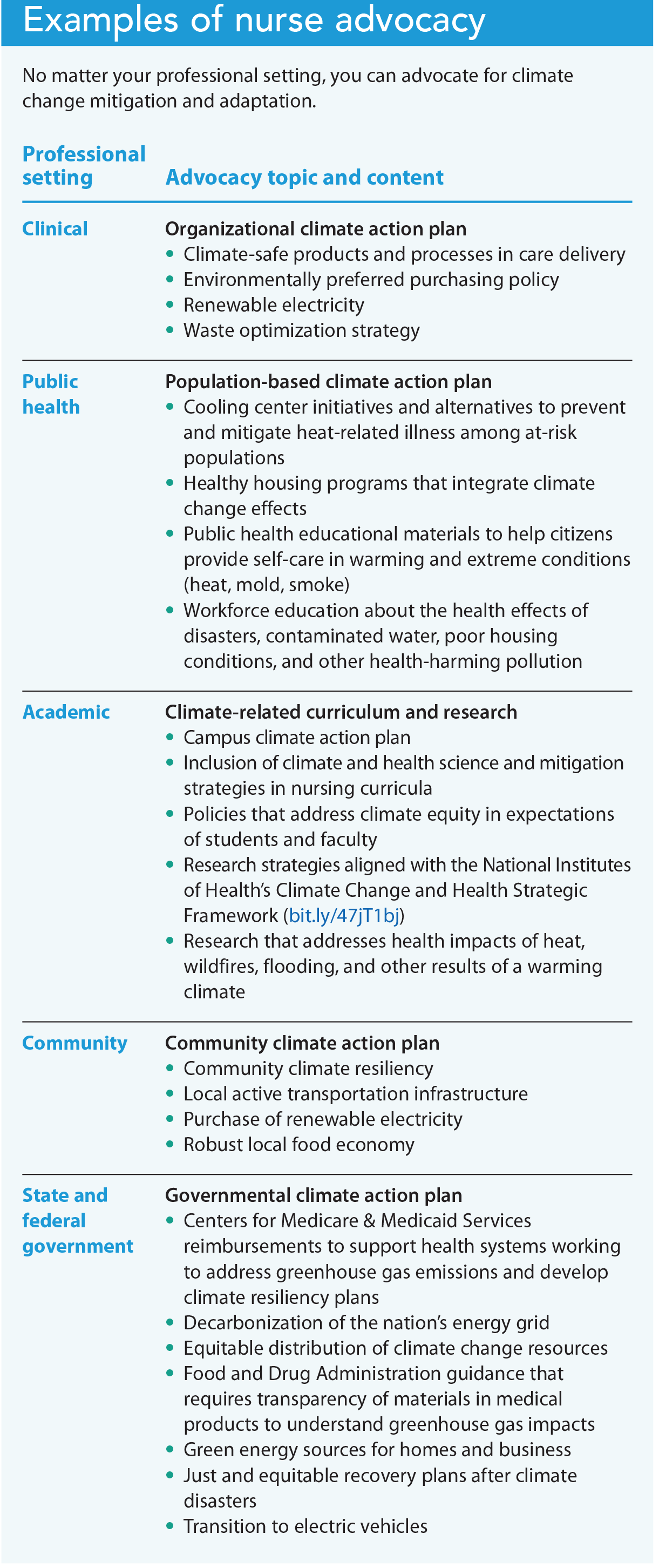

Nurses can use their powerful voices to advocate for planet-safe policies in healthcare and across society. Aligned with the Code, nurses can apply their influence to ensure that such policies promote health equity. The Alliance of Nurses for Healthy Environments offers a free e-book (envirn.org/e-textbook) to guide practical action that addresses environmental health and climate change. Nurses’ frontline knowledge about the health effects of disasters, contaminated water, poor housing conditions, and other health-harming pollution in communities can influence important policies to ensure they benefit everyone.
The resources available as a result of the 2022 Inflation Reduction Act, which provides billions of dollars to address environmental health, support nurses working on climate change mitigation and adaptation initiatives. Nurses play a crucial role in this whole-of-government approach. You can inform colleagues at all levels of government and healthcare leadership about your nursing assessments and knowledge of communities that face a disproportionate burden of exposure to environmental hazards and harms; your community and de-identified patient assessments that illustrate these environmental hazards and harms; and nurse-led interventions and programs that prevent and treat environmentally related symptoms and diseases to improve quality of life.
Many of the climate change funds and resources that resulted from the Inflation Reduction Act focus on community- and facility-level reduction of greenhouse gas emissions from energy sources, transportation sources, and supply chains. These are indirect care and non-clinical areas where nurses can exert their professional, shared governance influence within their organizations. Several opportunities exist to apply for funds to support nurse-led or nurse-centered cooperative, preventive, and public health interventions.
Strengthening hospital and patient population disaster preparedness and response planning are key areas relevant to nursing leadership interventions and innovations. Environmental justice examples include programs in at-risk communities to address heat-related illness prevention and patient education, interventions to protect nursing home residents from wildfire smoke exposure, environmental modifications to improve indoor air quality in schools or homes at risk for climate-related flooding mold and mildew, and increased asthma control and prevention among low-income children.
Take action now
As we recover together from the aftermath of the COVID-19 pandemic, we recommend climate change initiatives and healthcare organizations’ CSR as promising avenues for generating hope, implementing transformative improvements, and renewing professional nursing commitments. Take action now to address climate change and help remake meaning and social action for the nursing profession.
Jessica Castner is president of Castner Incorporated, in Grand Island, New York; professor and director of nursing at the University at Albany School of Public Health in Albany, New York; and 2021–2022 NAM Distinguished Nurse Scholar in Residence at the National Academy of Medicine in Washington, DC. Elizabeth Schenk is associate vice president of environmental stewardship at Providence Health headquartered in Renton, Washington, and assistant research professor at Washington State University College of Nursing in Spokane. Pamela F. Cipriano is president of the International Council of Nurses and professor of nursing at the University of Virginia School of Nursing, in Charlottesville.
Acknowledgment: The authors gratefully acknowledge the American Academy of Nursing, American Nurses Association, and American Nurses Foundation in support of the Distinguished Nurse Scholar in Residence at the National Academy of Medicine. This publication was also supported by the National Institute of Environmental Health Sciences of the National Institutes of Health under Award Number R25ES033452. The content is solely the responsibility of the authors and does not necessarily represent the official views of the National Institutes of Health.
American Nurse Journal. 2024; 19(1). Doi: 10.51256/ANJ012410
References
Alliance of Nurses for Healthy Environments. Environmental Health in Nursing. 3rd ed. 2023.
American Nurses Association. Code of Ethics for Nurses with Interpretive Statements. 2015. nursingworld.org/practice-policy/nursing-excellence/ethics/code-of-ethics-for-nurses
Hobfoll SE, Watson P, Bell CC, et al. Five essential elements of immediate and mid-term mass trauma intervention: Empirical evidence. Psychiatry. 2007;70(4):283-315. doi:10.1521/psyc.2007.70.4.283
Lindgreen A, Swaen V. Corporate social responsibility. Int J Manag Rev. 2010;12(1): 1-7. 10.1111/j.1468-2370.2009.00277.x
Mallon WT, Cox N. Climate Action in Academic Medicine: An Overview of How Medical Schools and Teaching Hospitals and Health Systems Are Responding to Climate Change. Association of American Medical Colleges. 2022. aamc.org/media/64106/download?attachment
National Academies of Sciences, Engineering, and Medicine. The Future of Nursing 2020-2030: Charting a Path to Achieve Health Equity. The National Academies Press; 2021. nam.edu/publications/the-future-of-nursing-2020-2030
National Academy of Medicine. Emerging Stronger From COVID-19: Priorities for Health System Transformation. 2022. nap.nationalacademies.org/read/26657/chapter/1
National Institutes of Health. Climate Change and Health Initiative Strategic Framework. February 2022. www.nih.gov/sites/default/files/research-training/initiatives/climate-change/nih-climate-change-framework.pdf
Nguyen MH, La VP, Le TT, Vuong QH. Introduction to Bayesian Mindsponge Framework analytics: An innovative method for social and psychological research. MethodsX. 2022;9:101808. doi:10.1016/j.mex.2022.101808
Robert Wood Johnson Foundation. The impact of extreme weather on views about climate policy in the United States. 2022. rwjf.org/content/rwjf/en/library/research/2022/06/the-impact-of-extreme-weather-on-views-about-climate-policy-in-the-united-states.html
Rodin J, Madsbjerg S. Making Money Moral: How a New Wave of Visionaries Is Linking Purpose and Profit. Philadelphia, PA: Wharton School Press; 2021.
Sampath B, Jensen M, Lenoci-Edwards J, Little K, Singh H, Sherman J. Reducing healthcare carbon emissions: A primer on measures and actions for healthcare organizations to mitigate climate change. Agency for Healthcare Research and Quality. September 2022. ahrq.gov/healthsystemsresearch/decarbonization/index.html
Tai DBG, Shah A, Doubeni CA, Sia IG, Wieland ML. The disproportionate impact of COVID-19 on racial and ethnic minorities in the United States. Clin Infect Dis. 2021;72(4):703-76. doi:10.1093/cid/ciaa815
U.S. Department of Health and Human Resources. Health sector resource hub. October 19, 2023. hhs.gov/climate-change-health-equity-environmental-justice/climate-change-health-equity/health-sector-resource-hub/index.html
Ursano RJ. Principles of psychological first aid: Core elements of disaster care, COVID-19 pandemic care and supportive psychotherapy. Psychiatry. 2021;84(4):309-10. doi:10.1080/00332747.2021.2005379
World Health Organization. World health statistics 2022: Monitoring health for the SDGs, sustainable development goals. who.int/publications/i/item/9789240051157
World Resources Institute. Greenhouse Gas Protocol. wri.org/initiatives/greenhouse-gas-protocol
Key words: climate change, corporate social responsibility, disaster recovery, professional governance

